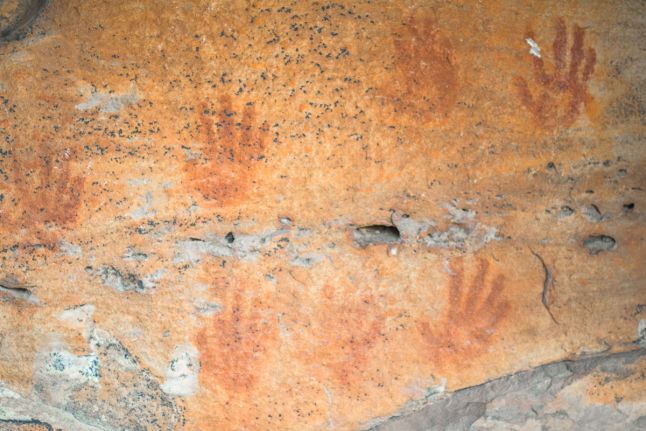Information signs at the Gulgurn Manja Shelter display the following text
CULTURAL LINKS
Gariwerd (the Aboriginal name for the Grampians) is of great cultural significance to local Aboriginal people. The clans of the two neighbouring language groups, the Djab wurrung and Jardwadjali, have lived here for many thousands of years.
The Djab wurrung lived on the plains to the east of Gariwerd and visited the eastern areas.
During autumn and early winter, the Jardwadjali lived mainly on the food rich plains to the west and north of Gariwerd. In late winter, spring and early summer food and water are more easily available. At this time the Jardwadjali ventured into the mountains for food resources and to fulfill religious and kinship obligations.
Creation stories and legends ensure a strong cultural link with the mountains. Songs, dances, stories and painting provide an important focus within Aboriginal communities today.
THE PLENTIFUL PLAINS
The nearby plains and their swamps, lakes and rivers have given Aboriginal people a good supply of food - waterbirds, emus, possums, kangaroos, lizards, tortoises, fish and eels.
Many local plants also provide food and resources - yam-daisy, eucalypts, wattles, banksias, cherry ballart and grass-trees.
Fire is an important tool. Regular burning (fire-stick farming) encourages new plant growth and increases food supplies. This still happens in areas such as the Kirrae wurrong land at Framlingham near Warrnambool.
THE ART AT GULGURN MANJA
Pronounced Gulkurn Munya (Hands of young People), this site features hand prints of many generations of young people, about 8 to 12 years old.
Some knowledge of the symbols and drawings in Gariwerd remains with the Aboriginal community, but much has been lost due to the impact of European settlement.
There are more than 100 Aboriginal rock art sites in Gariwerd - the richest Aboriginal rock art area in Victoria. Five of these sites are promoted to visitors.
THE STORY OF FIRE
Dangerous lightening and its fire have always lived in the mountains. On the other hand, useful or safe fire belonged to the crows of the plains, who would never allow other creatures to use it.
One day, a little bird called Yuuloin Keear (a Red-Browed Firetail) picked up, and escaped with, one of the crows' fire sticks. Tarrakukk (a hawk) in turn took the fire stick from Yuuloin Keear and dropped it to the ground, starting a bushfire from which the Jardwadjali and Djab wurrung gained access to fire.
Uncontrolled and dangerous fire versus controlled and safe fire - a lesson to remember!
COME AND VISIT BRAMBUK
Discover more about Aboriginal culture at the Brambuk Living Cultural Centre. Located at Halls Gap, the Centre has interesting displays, an art and craft shop, a cafe and restaurant and a colourful garden featuring Gariwerd plants.
Brambuk is run by five Aboriginal communities from south-west Victoria and the Wimmera.
Ask about the art site tours and other activities conducted by Brambuk.
Brambuk shares responsibility for the cultural heritage of Gariwerd with Aborignal Affairs Victoria and the Department of Conservation and Natural Resources.
RESPECT FOR GULGURN MANJA
You are in a national park. All plants, animals and cultural heritage sites are protected.
This is an important Aboriginal cultural heritage site.
Please treat Gulgurn Manja with respect.
Source: Information sign along the walking track to Gulgurn Manja, provided by Brambuk Aboriginal Cultural Centre and the Department of Conservation and Natural Resources.
ART OF GENERATIONS
On the shelter's ceiling you can see stokes, bars and handprints.
The pigment for these motifs is ochre, ground into a powder and mixed with water or egg yolk.
The artists used their fingers and hands to make these designs, which have been renewed and added to over many generations.
TCHINGAL'S TRACKS?
At the rear of the shelter you can see paintings of emu tracks. Emus are common and were a reliable food source.
An important creation story tells of a huge, ferocious emu called Tchingal, who created Barigar Gap (Roses Gap) and Yananginj Njawi Gap (Victoria Gap) while in pursuit of War the crow.
Do these motifs represent Tchingal's tracks... or emus that were hunted for food?
HARD ROCK, WATER AND WIRE
The rock shelter is made of very hard quartz-rich sandstone, and the smooths surfaces are ideal for painting.
Dust, water, stains, algae, lichen, flaking of the rock face, deposition of leached salt, vandalism and graffiti all threaten the art.
Drip lines (lines of silica to re-direct running water) and the wire grille help to protect this important rock art site.
YOUNG PEOPLE'S HANDS
Hands were dipped in red ochre paint and then placed on the wall to leave a print.
What did this place mean to the Jardwadjali? The art features young people's hand prints... and the right hand only!
Much knowledge about the art has been lost. The remaining knowledge and traditions are maintained by the local Aboriginal communities and handed down from generation to generation.
This is a vital part of Aboriginal life and well being.
ARTISTS AND TOOLMAKERS
On the rock wall, you can see a section where the rock edge has been broken away.
This is an example of wall bettering, a process of striking the rock with a hammer stone to produce stone flakes. These flakes are then carefully worked to make stone tools.
Notice that this shelter faces north-east, giving protection from the prevailing south-westerly rains for artists, toolmakers and you.
Source: Information signs along the fence at the Gulgurn Manja Shelter.

